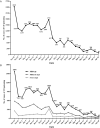Acute carbon monoxide poisoning in Shandong, China: an observational study
- PMID: 35263071
- PMCID: PMC9532052
- DOI: 10.1097/CM9.0000000000001942
Acute carbon monoxide poisoning in Shandong, China: an observational study
Abstract
Background: Carbon monoxide (CO) poisoning remains a major cause of accidental injuries and multiple studies have indicated that CO is also associated with significantly severe or long-term toxicity to the central nervous system. Given that CO poisoning causes serious morbidity and mortality, a better understanding of epidemiological features and clinical characteristics of acute CO poisoning in China is crucial.
Methods: We collected the clinical data of acute CO poisoning in patients between November 2019 and April 2020 across Shandong province, China and analyzed its characteristics focusing on the weekly amount and the severity of the confirmed cases.
Results: A total number of 21,088 acute CO poisoning cases were diagnosed. The overall incidence of acute CO poisoning was approximately 0.021%. On severity rankings, 63% of confirmed cases (n = 13,378) were mild, 27% (n = 5635) were moderate, and 10% (n = 2075) were severe. Interestingly, the coastal cities had more confirmed cases than the inland/suburban areas in Shandong. Meanwhile, the number of confirmed cases was negatively correlated with the local mean daily temperature (P = 0.0167).
Conclusions: Mild acute CO poisoning cases accounted for the majority of all confirmed cases during the winter of 2019. In Shandong province, which is located in east China, residents of the coastal cities are more susceptible to CO poisoning than residents of inland cities.
(C) 2022 by Lippincott Williams & Wilkins, Inc.
Conflict of interest statement
None.
Figures



Similar articles
-
[Epidemiological characteristics and medical expenses of acute occupational poisoning hospitalization in 5 monitoring counties (cities, districts) of Shandong Province from 2012 to 2018].Zhonghua Yu Fang Yi Xue Za Zhi. 2019 Dec 6;53(12):1296-1298. doi: 10.3760/cma.j.issn.0253-9624.2019.12.017. Zhonghua Yu Fang Yi Xue Za Zhi. 2019. PMID: 31795589 Chinese.
-
Early predictors of brain injury in patients with acute carbon monoxide poisoning and the neuroprotection of mild hypothermia.Am J Emerg Med. 2022 Nov;61:18-28. doi: 10.1016/j.ajem.2022.08.016. Epub 2022 Aug 18. Am J Emerg Med. 2022. PMID: 36029667
-
Non-Fire Related Carbon Monoxide Poisoning in Sichuan, China: A 9-Year Study (2008-2016).Iran J Public Health. 2019 Mar;48(3):458-464. Iran J Public Health. 2019. PMID: 31223573 Free PMC article.
-
Management of carbon monoxide poisoning.Chest. 1990 Jan;97(1):165-9. doi: 10.1378/chest.97.1.165. Chest. 1990. PMID: 2403894 Review.
-
The neurotoxicology of carbon monoxide - Historical perspective and review.Cortex. 2016 Jan;74:440-8. doi: 10.1016/j.cortex.2015.07.033. Epub 2015 Aug 15. Cortex. 2016. PMID: 26341269 Review.
Cited by
-
An urgent health problem of indoor air pollution: results from a 15-years carbon monoxide poisoning observed study in Jinan City.Sci Rep. 2023 Jan 28;13(1):1619. doi: 10.1038/s41598-023-28683-0. Sci Rep. 2023. PMID: 36709374 Free PMC article.
-
Predictors of delayed encephalopathy after acute carbon monoxide poisoning: a literature review.Front Med (Lausanne). 2025 Mar 26;12:1559264. doi: 10.3389/fmed.2025.1559264. eCollection 2025. Front Med (Lausanne). 2025. PMID: 40206479 Free PMC article. Review.
References
-
- Ernst A, Zibrak JD. Carbon monoxide poisoning. N Engl J Med 1998; 339:1603–1608. doi: 10.1056/NEJM199811263392206. - PubMed
-
- Zhang L, Sun Q, Xin Q, Qin J, Zhang L, Wu D, et al. . Hyperbaric oxygen therapy mobilized circulating stem cells and improved delayed encephalopathy after acute carbon monoxide poisoning with up-regulation of brain-derived neurotrophic factor. Am J Emerg Med 2021; 42:95–100. doi: 10.1016/j.ajem.2021.01.021. - PubMed
LinkOut - more resources
Full Text Sources
Miscellaneous

